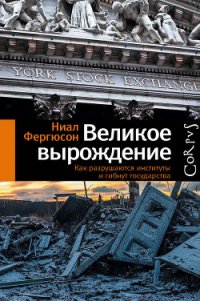Злой рок. Политика катастроф - Фергюсон Ниал (книги бесплатно без регистрации .txt, .fb2) 📗
Вернуться
276
C. Nunziata and M. R. Costanzo, «Ground Shaking Scenario at the Historical Center of Napoli (Southern Italy) for the 1456 and 1688 Earthquakes», Pure and Applied Geophysics 177 (January 2020), pp. 3175–3190, https://doi.org/10.1007/s00024-020-02426y.
Вернуться
277
A. Amoruso et al., «Spatial Reaction Between the 1908 Messina Straits Earthquake Slip and Recent Earthquake Distribution», Geophysical Research Letters 33, no. 17 (September 2006), p. 4, https://doi.org/10.1029/2006GL027227.
Вернуться
278
Giuseppe Restifo, «Local Administrative Sources on Population Movements After the Messina Earthquake of 1908», Istituto Nazionale di Geofisica e Vulcanologia (INGV) Annals of Geophysics 38, nos. 5–6 (November – December 1995), pp. 559–566, https://doi.org/10.4401/ag4058; Heather Campbell, «Messina Earthquake and Tsunami of 1908», Encyclopaedia Britannica, January 29, 2020, https://www.britannica.com/event/Messina-earthquake-and-tsunamiof1908.
Вернуться
279
Emanuela Guidoboni, «Premessa a terremoti e storia», Quaderni Storici 20, no. 60 (3) (December 1985), pp. 653–664, https://www.jstor.org/stable/43777325.
Вернуться
280
Giacomo Parrinello, «Post-Disaster Migrations and Returns in Sicily: The 1908 Messina Earthquake and the 1968 Belice Valley Earthquake», Global Environment 9 (2012), pp. 26–49, http://www.environmentandsociety.org/sites/default/files/key_docs/ge9_parrinello.pdf.
Вернуться
281
A. S. Pereira, «The Opportunity of a Disaster: The Economic Impact of the 1755 Lisbon Earthquake», Journal of Economic History 69, no. 2 (June 2009), pp. 466–499.
Вернуться
282
Pereira, «Opportunity of a Disaster», pp. 487f.
Вернуться
283
Gregory Clancey, «The Meiji Earthquake: Nature, Nation, and the Ambiguities of Catastrophe», Modern Asian Studies 40, no. 4 (2006), p. 920.
Вернуться
284
Gregory Clancey, «Japanese Seismicity and the Limits of Prediction», Journal of Asian Studies 71, no. 2 (May 2012), p. 335.
Вернуться
285
Christopher Sholz, «What Ever Happened to Earthquake Prediction?» Geotimes 17 (1997), pp. 16–19.
Вернуться
286
Ishibashi Katsuhiko, «Why Worry? Japan ’s Nuclear Plans at Growing Risk from Quake Damage», International Herald Tribune, August 11, 2007, reposted on Asia-Pacific Journal: Japan Focus, http://www.japanfocus.org/-Ishibashi-Katsuhiko/2495.
Вернуться
287
Richard A. Clarke and R. P. Eddy, Warnings: Finding Cassandras to Stop Catastrophes (New York: HarperCollins, 2018), pp. 76ff., 92, 96f.
Вернуться
288
Peter Symonds, «The Asian Tsunami: Why There Were No Warnings», World Socialist Web Site, January 3, 2005, https://www.wsws.org/en/articles/2005/01/warn-j03.html.
Вернуться
289
«Scientist Who Warned of Tsunamis Finally Heard», NBC News, November 1, 2005, https://www.nbcnews.com/id/wbna6813771. См. также: Natalie Muller, «Tsunami Warning: Why Prediction Is so Hard», Australian Geographic, May 11, 2012, https://www.australiangeographic.com.au/topics/science-environment/2012/05/tsunami-warning-why-predictionissohard/.
Вернуться
290
Becky Oskin, «Two Years Later: Lessons from Japan’s Tohoku Earthquake», LiveScience, March 10, 2013, https://www.livescience.com/27776-tohoku-two-years-later-geology.html.
Вернуться
291
Clarke and Eddy, Warnings, pp. 81–82.
Вернуться
292
Ari M. Beser, «One Man’s Harrowing Story of Surviving the Japan Tsunami», National Geographic, March 23, 2016, https://blog.nationalgeographic.org/2016/03/23/exclusive-one-mans-harrowing-storyofsurviving-the-japan-tsunami/.
Вернуться
293
Clancey, «Japanese Seismicity», p. 333.
Вернуться
294
Harrison Salisbury, The Great Black Dragon Fire (New York: Little, Brown, 1989).
Вернуться
295
Rev. Peter Pernin and Stephen J. Pyne, The Great Peshtigo Fire: An Eyewitness Account (Madison: Wisconsin Historical Society Press, 1999), Kindle ed., loc. 273–275. Самый крупный природный пожар, случившийся в 2020 году в Калифорнии, «Августовский комплексный пожар» («August Complex»), сжег чуть больше миллиона акров (более 4046 кв. км) и не достиг величины пожара в Пештиго.
Вернуться
296
Erin Blakemore, «Why America’s Deadliest Wildfire Is Largely Forgotten Today», History, August 4, 2017 (updated September 1, 2018), https://www.history.com/news/why-americas-deadliest-wildfireislargely-forgotten-today.
Вернуться
297
Pernin and Pyne, Great Peshtigo Fire, loc. 273–275.
Вернуться
298
Pernin and Pyne, Great Peshtigo Fire, 413–414.
Вернуться
299
Pernin and Pyne, Great Peshtigo Fire, loc. 437–447. См. также: Tom Hultquist, «The Great Midwest Fire of 1871», https://www.weather.gov/grb/peshtigofire2.
Вернуться
300
A. Korotayev et al., «A Trap at the Escape from the Trap? Demographic-Structural Factors of Political Instability in Modern Africa and West Asia», Cliodynamics 2, no. 2 (2011), pp. 276–303.
Вернуться
301
Пер. А. Суркова. Из кн.: Мао Цзэ-дун. Восемнадцать стихотворений / Под редакцией Н. Федоренко и Л. Эйдлина. М., 1957.
Вернуться
302
Thayer Watkins, «The Catastrophic Dam Failures in China in August 1975», San José State University Department of Economics, n.d., https://www.sjsu.edu/faculty/watkins/aug1975.htm.
Вернуться
303
Yi Si, «The World’s Most Catastrophic Dam Failures: The August 1975 Collapse of the Banqiao and Shimantan Dams», in The River Dragon Has Come!, ed. Dai Qing (New York: M. E. Sharpe, 1998).
Вернуться
304
Eric Fish, «The Forgotten Legacy of the Banqiao Dam Collapse», Economic Observer, February 8, 2013, http://www.eeo.com.cn/ens/2013/0208/240078.shtml; Justin Higginbottom, «230,000 Died in a Dam Collapse That China Kept Secret for Years», Ozy, February 17, 2019, https://www.ozy.com/true-and-stories/230000-diedinadam-collapse-that-china-kept-secret-for-years/91699/; Kenneth Pletcher and Gloria Lotha, «Typhoon Nina – Banqiao Dam Failure», Encyclopaedia Britannica (2014), https://www.britannica.com/event/Typhoon-Nina-Banqiao-dam-failure. См. также: N. H. Ru and Y. G. Niu, Embankment Dam – Incidents and Safety of Large Dams (Beijing: Water Power Press, 2001) (на китайском языке).
Вернуться
305
Yi, «World’s Most Catastrophic Dam Failures».
Вернуться
306
Катастрофа, которая может произойти при прорыве «Трех ущелий» – а она была вполне реальна после сильных ливней в июле 2020 года, – приведет к тому, что 10 миллиардов кубометров воды устремятся вниз по течению к таким крупным торгово-промышленным и общественным центрам, как Ичан (население 4 млн), Ухань (11 млн), Нанкин (8,5 млн), Чанчжоу (4,6 млн) и Шанхай (24,3 млн), и поставит под угрозу жизнь и пропитание 350 млн человек, зальет четверть пахотных земель Китая и, вероятно, потопит примерно половину сухопутных подразделений Народно-освободительной армии. (Прим. авт.)




